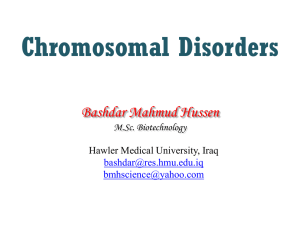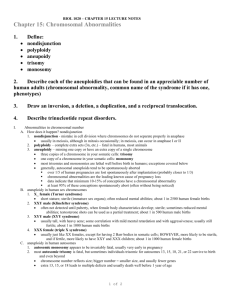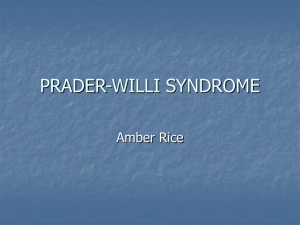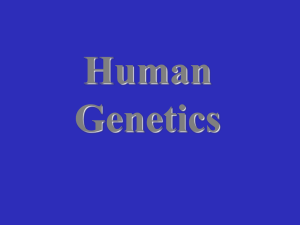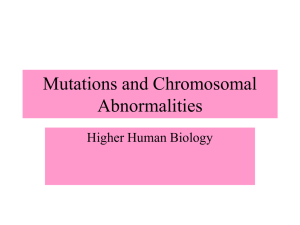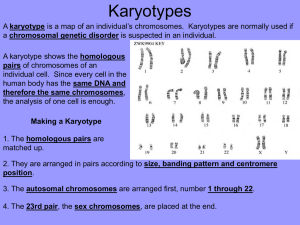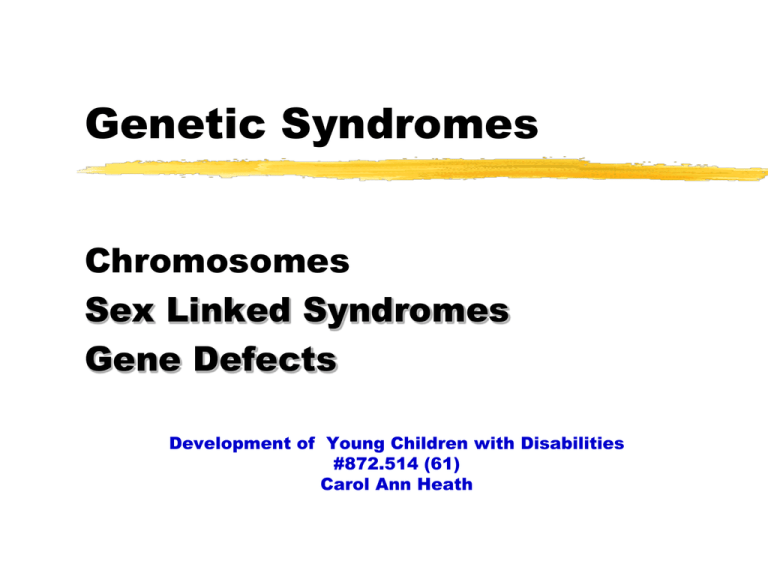
Genetic Syndromes
Chromosomes
Sex Linked Syndromes
Gene Defects
Development of Young Children with Disabilities
#872.514 (61)
Carol Ann Heath
CHROMOSOMAL
ABNORMALITIES
What is a Trisomy?
A chromosomal anomaly characterized by
the presence of an extra chromosome in
the cells
A trisomy occurs when there are 47
chromosomes instead of 46
A partial trisomy occurs when just part of
an extra chromosome attaches to another
Trisomy continued
Mosaic trisomy occurs when the extra
chromosome material is not present in every
cell
The most common known trisomies are:
Trisomy 21 (Down syndrome)
Trisomy 18 (Edward’s syndrome)
Trisomy 13 (Patau’s syndrome)
Trisomy 21: Down syndrome
Extra 21st chromosome; 47 chromosomes
in each cell
1/800 births
Approximately 5,000 children with Down
syndrome born each year in U.S.
1% chance of reoccurrence
Life expectancy: approximately 55 years
Down syndrome
96% of children with Down syndrome
have the extra chromosome 21
4% have either a translocation (attached
to or incorporated into another
chromosome in the egg or sperm) or a
form called “Mosaic” in which not all cells
affected.
Mosaic children may be less delayed
Prevalence
Prevalence increases with maternal age:
29 years and younger
30-34 years
35-39 years
40-44 years
over 45 years
1/1500
1/800
1/270
1/100
1/50
Physical Characteristics
Hypotonia
short neck
oval-shaped eyes
(excess skin)
epicanthal folds
single palmar creases
small nose
flattened nasal bridge
small oral cavity
small ears that may fold slightly at top
Health problems associated
with Down syndrome
40-50% have congenital heart defects
Respiratory problems, especially upper
respiratory infections
Eye and ear problems including hearing loss
Thyroid problems
Cervical spine abnormalities
Gastrointestinal problems
Down syndrome continued
Most have some degree of mental retardation
ranging from mild to severe.
Average person functions in mild to moderate
range.
Education in public schools
Perform daily living skills independently
Can marry and have children (rare for men)
Women have 50% their child will have DS
Development
Better prognosis due to:
better health care
early intervention
more normal family and social
experiences
better educational opportunities
more positive social attitudes
Development continued
Social and emotional development in
infancy delayed, they progress in the first
year is essentially normal.
Hypotonia delays motor skills which
restricts their early experiences.
Visual exploration and eye-contact
delayed in first year.
Development continued
Expressive language skills delayed
May be able to sign words before
verbalizing them
3/4 children have speech production
problems
4/5 may experience some degree of
hearing loss (fluctuating caused by o.m.)
Development continued
Many children have auditory-perceptual
impairment (tree/cheese)
At risk for dyspraxia-inability to perform
coordinated movements
Benefits of sign language
A way of teaching speech and language
Method of communicating and expression
Develop comprehension of speech
Assisting with Language
Sign language
computers
open/closed questions
role play
synthesized speech
Reading
Most early reading books contain too little
text and text that is too complex
Reading single words first:
matching
selecting
naming
Trisomy 13
Sometimes referred to as Patau Syndrome
Described in 1657, etiology not
discovered until 1960 by Dr. Klaus Patau
Extra 13th chromosome which results in
significant multiple defects in major organ
systems
Brain most severely affected
Many born blind, deaf, no sense of smell
Trisomy 13
1/8000 births
Median survival is 2.5 days
82% die within the first month
5% survive first 6 months
Those surviving longer have severe
mental defects, seizures, and failure to
thrive
Only 1 adult known to survive to age 33
Abnormalities
80% heart defect
60-80% cleft lip, cleft palate or both
Found in 50% or more patients:
central nervous system
hearing
cranium
eyes
skin
hands and feet
skeletal
genitalia
Etiology
Maternal age has been a factor with
occurrence
Chance of recurrence is thought to be low
Trisomy 13 mosaicism usually show a less
severe clinical phenotype, survival may be
longer, and mental deficiency variable
Trisomy 18
Also known as Edward’s syndrome
Discovered in 1960 by Dr. John Edwards
Caused by an extra 18th chromosome
It is the second most common multiple
malformation syndrome
1/6,600 births
Affects females 3:1
Trisomy 18
50% die within first week
Only 5-10% survive the first year as
“severely mentally defective individuals”
10 children over the age of 10 reported
Most unable to walk and language limited,
but some older children who survive may
interact and relate to family members.
Abnormalities
Growth deficiency
congenital anomalies of the heart, lung,
kidneys, and diaphragm
increased muscle tone
small mouth and jaw
mental deficiency
microcephaly
Abnormalities continued
Low set malformed ears
small pelvis, limited hip abduction
underdeveloped nails
underdeveloped or absent thumbs
abnormal genitalia
episcanthal folds
Etiology
Maternal age contributing factor to
occurrence
1% chance of recurrence
Moscaicism leads to partial clinical
expression, longer survival and various
degrees of variations
Sex Linked
Abnormality in the overall number of
chromosomes for X and Y
Male has one X and One Y
Female has two X
Disorders
Turner syndrome: female abnormality
Female has only one X, total of 45, not 46
chromosomes, resulting in XO pattern
Only case in which too few chromosomes
can develop into an embryo and survive
1/5000 female births
Turners
Very short <5 ft
Lowered hairline, broad chest and short
neck
Ovaries do not function normally
IQ in typical range with learning
disabilities, particularly visual-perceptual
and mathematics
Klinefelter syndrome
Males has extra X chromosome, resulting
in 47
Pattern of XXY
1/500 males
Taller and thinner; underdeveloped
secondary sex traits; decreased hormone
level
Language delays; normal adulthood
Chromosome deletions
Sometimes genetic material is missing from a
chromosome. These chromosomes are said to
have “deletions”.
Interstitial deletions occur when a chromosome
has broken, genetic material has been lost, and
the chromosome arms rejoin
Larger deletions lead to death
Chromosomal Errors
Deletion #22q11.2 syndrome
Williams syndrome
Fragile X
Cri du chat
Cri du chat syndrome
First described in 1963 by Lejeune
Syndrome associated with deletion of the
short arm of chromosome5
Deletion can vary in size from extremely
small (involving only one band) to the
entire short arm
Majority of children die in early childhood,
some survive into adulthood with low IQ
Prevalence
One of the most common deletion
syndromes
Varying between 1/20,000 and 1/50,000
Abnormalities
Low birth weight
Slow growth
cat-like cry
hypotonia
mental deficiency
microcephaly
strabismus
72%
100%
100%
78%
100%
100%
61%
Abnormalities continued
Round face
epicanthal folds
Low set and/or poorly
formed ears
congenital heart disease
68%
85%
57%
30%
Development
As babies, unusually squirmy
Cat-like cry that becomes less prominent with
age
With special schooling and supportive home
environment, some children have attained social
and psychomotor skills of a 5 to 6 year old
50% had vocabulary adequate for
communication
William syndrome
Described in 1961 by Williams
deletion of one allele located within
chromosome subunit 7q11.23
1/20,000 births
Abnormalities
Mild growth deficiency
mild microcephaly
small upturned nose
long philtrum
epicanthal folds
cardiac anomalies
joint limitations
Performance
Average IQ is 56 (range 40-80)
Hoarse voice
Hypersensitive to sound
Mild neurologic dysfunction
Poor coordination
Decreased perceptual and motor function
Language ability much greater than cognitive
ability
Development
Infancy: feeding problems, colicky, fretful
Childhood: outgoing, no fear of
strangers, strong interest in others
2/3 of children: difficult temperament,
more negative moods, increased activity,
distractible, less persistence, and low
threshold arousal
Development continued
As adults: progressive medical problems
Most live with parents or in group home
Sudden death reported in a number of
children
Deletion #22q11.2
syndrome
Previously known as DiGeorge syndrome
1 out 5000 births
Common cause of genetic heart malformation
Facial anomalities: small mouth, narrow eyes,
bulbous nose, palate
Immune deficiency
Typical cognitive ranges with learning
disabilities, particularly in math
Fragile X Syndrome
Mental Impairment
Females:
learning disabled in math
exceptional with reading and spelling
1/3 have mental disabilities similar to those
associated with schizophrenia
Males:
process information in simultaneous fashion
Sees whole in order to understand the parts
Speech and Language
Rapid bursts
Echolalic
Perseveration most difficulty for males
Talking inappropriately
One topic
Speech problems made worse if anxious
Behavioral Problems
ADHD
Temper tantrums
Mood swings
Aggression
Strong reaction to change in environment
Sensory integration
Autistic like behaviors
Medical Problems
At greater risk for otitis media
Myopia
“Lazy eye”
Orthopedic difficulties related to flat feet
and joint laxity
20% of males prone to seizures
Digestive disorders
Education
Early Intervention
Mainstreaming
Occupational therapy
Speech therapy
Physical therapy
Visual devices
Fragile X
Identified by a break or weakness on the
long arm of the X chromosome
FMR-1
X linked
“Genetic anticipation”
Testing for Fragile X
Fragile X syndrome
Most Common Genetically inherited form
of mental retardation
1991 clinical method of diagnosing
Occurs in 1/1000 male births
Occurs in 1/2500 female births
Life span is normal
Physical Characteristics
Long narrow face
Large or prominent ears
Macroorchidism
Abnormalities of connective tissue:
double jointed fingers
Flat feet
Heart Murmur
Mental Impairment
80% of males have mental impairment
ranging from severe retardation to lownormal intelligence
Majority: mildly to moderately retarded
30% of females have some degree of
mental retardation
IQ appears to decline with age
Mental Impairment cont.
Common learning disabilities include
delayed speech
attention problems
hyperactivity
math
Good with imitation
Very social
Visual Memory



